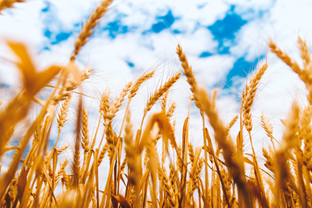Blog - What is polyploidy and how does it affect wheat? - An interview with Dr Phillipa Borrill
Heather Jones interviewed our guest speaker Dr Phillipa Borrill from the Department of Crop Genetics at the John Innes Centre about her work studying bread wheat genetics and her career so far.

Author: Heather Jones, Editor: Tea Reinert
DNA that makes up our genome is grouped into units called chromosomes. For example, humans have 46 chromosomes split into 2 sets. Some species have multiple sets of the same chromosomes – we called these polyploids. The wheat used to make bread is hexaploid – it has 6 sets of chromosomes! We don’t know much about how gene expression is regulated in species with these giant genomes, and Dr Borrill is using wheat to try to answer this question. In particular, Dr Borrill is interested in understanding the regulation of genes that control plant death (a process called senescence) and the movement of nutrients from the leaves during senescence to the grain. Her talk was titled ‘Crop improvement for wheat using the power of polyploidy.’ Read on for Heather’s interview with Dr Borrill.
What is wheat polyploidy and why is it important?
“My talk today focused on three questions: 1) Why is polyploidy so important?; 2) Why should we study it now?; and 3) How can we escape polyploidy? Polyploidy is not unusual - most flowering plants have polyploidy somewhere in their evolutionary history, and many of our modern crops are polyploid. This means that many crop plants have multiple sets of homologous chromosomes (chromosomes with the same structure and same genes). All these gene copies makes gene regulation complicated! My lab has been involved in developing key tools to try to understand polyploidy in wheat and how genes are regulated. These new tools have made wheat genetics such an exciting field of study, with the integration of modern resources generating novel insights into its large, complex genome. Our work so far has found that for some genes some of the copies are turned off leaving only 1 that is expressed highly, for other genes all of the copies are all expressed at the same level – what makes them different is what we are trying to understand now. If we can answer this question, we can predict which gene copies are going to be most important for crop improvement.”
What are your research goals for your lab?
“We want to understand duplicated and ‘useless’ genes in polyploid wheat, this understanding will help us to improve wheat yields and nutrition.”
What drew you to crop genetics, and why do you think other people should be interested in it?
“I’ve always been interested in how plants grow, and how they have such huge diversity. And I wanted my research to have real world impact, and the world depends on its crops! Recently, there’s been such a huge transformation in crop science, making it an exciting research area.”

Do you have any advice for undergraduate students, PhD students, or early career scientists?
“Be curious! Be open to new opportunities. Some of the most interesting things that I’ve worked on have been things I have just happened upon. Take advantage of those opportunities you find – or that find you – along the way.”
Are there things that you would like to see change within your field?
“More women! We’re underrepresented – we need more women-led research groups, definitely. But in general things are very good - there's been such huge growth and development in resources and collaboration that it's genuinely such a nice place to work.”
You’ve won a lot of prizes! Any tips for getting yourself and your research out there?
“Apply for them! There’s a lot of things you can nominate yourself for, or have a colleague do for you, and no-one tells you about them. But they’re there!”

